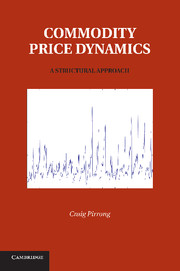Book contents
- Frontmatter
- Contents
- Preface
- 1 Introduction
- 2 The Basics of Storable Commodity Modeling
- 3 High-Frequency Price Dynamics for Continuously Produced Commodities in a Two-Factor Storage Economy: Implications for Derivatives Pricing
- 4 The Empirical Performance of the Two-Factor Storage Model
- 5 Stochastic Fundamental Volatility, Speculation, and Commodity Storage
- 6 The Pricing of Seasonal Commodities
- 7 The Dynamics of Carbon Markets
- 8 The Structural Modeling of Non-Storables: Electricity
- References
- Author Index
- Subject Index
5 - Stochastic Fundamental Volatility, Speculation, and Commodity Storage
Published online by Cambridge University Press: 05 June 2012
- Frontmatter
- Contents
- Preface
- 1 Introduction
- 2 The Basics of Storable Commodity Modeling
- 3 High-Frequency Price Dynamics for Continuously Produced Commodities in a Two-Factor Storage Economy: Implications for Derivatives Pricing
- 4 The Empirical Performance of the Two-Factor Storage Model
- 5 Stochastic Fundamental Volatility, Speculation, and Commodity Storage
- 6 The Pricing of Seasonal Commodities
- 7 The Dynamics of Carbon Markets
- 8 The Structural Modeling of Non-Storables: Electricity
- References
- Author Index
- Subject Index
Summary
Introduction
The previous chapter showed that the traditional commodity storage model cannot capture some features of the behavior of continuously produced commodity prices, in particular the behavior of price volatility. Although the standard model can generate time variation in spot and forward volatility that matches some features documented in empirical data, it cannot generate volatility levels that reach those observed in actual prices. Moreover, it cannot generate in forward price-implied volatilities similar to those observed in the data.
In the model studied in the earlier chapters, variations in price volatilities resulted from variations in the degree of supply-demand tightness in the market. Volatility peaks in these models when stocks are low and/or demand is high. That is, volatility is a consequence of supply-and-demand fundamentals in this model. These results suggest that to generate richer volatility behavior, it is necessary to introduce another factor related to volatility that is not driven completely by the y and z shocks.
An obvious way to do this is to make the variability of the fundamental net demand shocks stochastic – that is, to introduce stochastic fundamental volatility.
The introduction of this factor is not ad hoc because there is considerable independent basis to believe that the supply and demand for commodities exhibit stochastic volatility. For instance, for industrial commodities such as copper, demand is affected by macroeconomic factors. Moreover, (a) stock prices also reflect macroeconomic fundamentals, and (b) stock prices exhibit stochastic volatility.
- Type
- Chapter
- Information
- Commodity Price DynamicsA Structural Approach, pp. 109 - 130Publisher: Cambridge University PressPrint publication year: 2011
- 2
- Cited by

